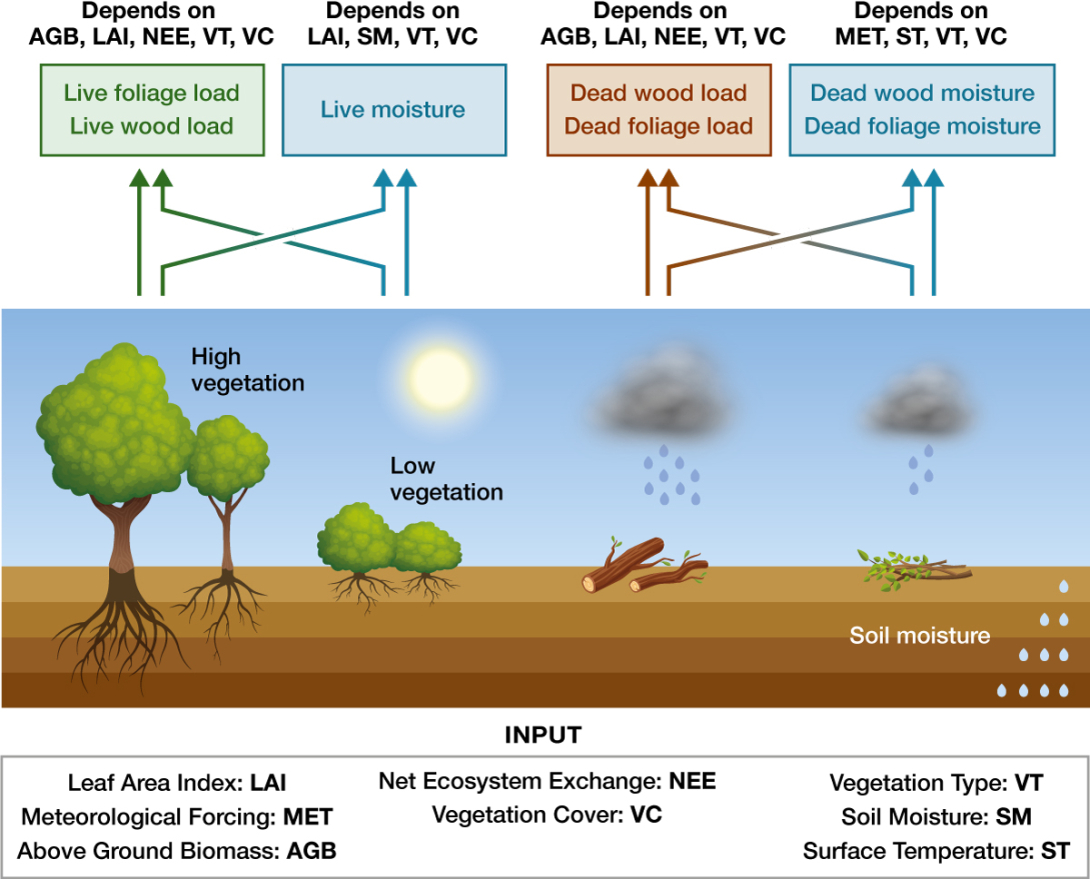Landscape fires impact local ecosystems, communities, air quality and global atmospheric conditions, often with devasting consequences. Effective wildfire management and prevention strategies depend on accurate forecasts of fire danger. The backbone of the early warning component of the EU’s Copernicus Emergency Management Service (CEMS), and the most used index by forest agencies and meteorological services in Europe, is the fire weather index (FWI), which was developed in the 1970s. ECMWF has been producing FWI forecasts since 2017 as part of its duties as the computational centre for the CEMS fire activity. The FWI uses atmospheric conditions and effectively estimates the moisture content of dead vegetation. A major limiting factor to this approach is the lack of consideration of vegetation abundance or type. Furthermore, as the FWI was trained in specific conditions, Canadian pine forests, it has been shown to have limitations when applied at a global scale. As part of ECMWF’s continuing effort to broaden the use of our Integrated Forecasting System (IFS) into the field of environmental forecasting, specifically to provide more accurate fire forecasts, a new global fuel characteristic model and a ten‑year dataset have been developed (see https://doi.org/10.5194/bg-21-279-2024). These combine meteorological and land surface variables from the IFS with satellite observations. This newly developed mid-complexity model is part of an overall ambitious plan to develop a fire module – SPARKY – for the IFS. In its present form, the fuel component of SPARKY provides real-time daily forecasts of fuel composition and state with a grid spacing of 9 km.

Seeing the wood for the trees
The most notable limitation of existing fire danger metrics used in early warning systems is the lack or simplification of fuel availability. For example, a static fuel map may be used. At the climate scale, this is overcome with the use of dynamic vegetation models, although these lack consensus at fine spatial resolutions and fail to account for the impact of human-induced disturbances on the landscape.
A new fuel model developed at ECMWF is initialised from satellite observations of above-ground fuel, taken from a multi-year European Space Agency – Climate Change Initiative (ESA CCI) product. To provide daily fuel updates, the model incorporates variations in vegetation amount output from the land surface component of the IFS, ECLand. As ECLand has some biases, the model employs a bias correction scheme, which is used by the EU’s Copernicus Atmosphere Monitoring Service (CAMS) implemented by ECMWF, to provide more accurate carbon fluxes. To account for changes in total fuel mass, and not just the carbon component, the fuel model is further bias-corrected using the difference in above-ground fuel from ESA CCI from consecutive years. This results in daily estimates of total fuel load.
The next step is to categorise the fuel load into live wood, live leaves, dead wood, and dead foliage mass. This is done by considering the type of vegetation used in ECLand and using satellite estimates of the vegetation state, using a variable known as the leaf area index (LAI). Using these methods, the model estimates that 78% of the above-ground fuel globally is alive, whilst the remaining 22% is dead, although this varies depending on location and season. Of the living component, 97% comprises woody fuel and 3% is leafy fuel. The dead fuel is approximately equally weighted between wood and foliage, where the foliage includes small twigs and branches.
The moisture state
Although existing fire danger metrics make estimations of the moisture content of dead vegetation, these are often simplified and do not extend to the state of living fuel. The newly developed ECMWF fuel model estimates both live fuel moisture content (LFMC) and dead fuel moisture content (DFMC), further dividing the DFMC between woody and foliage fuel.
Estimations of LFMC are made using a combination of observed vegetation state, LAI, modelled soil moisture, and mapped vegetation types. These are combined to give an estimated LFMC, which sums three components of vegetation hydrology: winter moisture content is when dormant vegetation is dependent on soil moisture alone; drought resistant moisture content is dependent on the LAI alone; the combined active season moisture content is estimated by combining soil moisture and LAI. The model was optimised with a theoretical maximum LFMC per vegetation type, using observations taken from vegetation samples in the field.
A well‑tested DFMC model, known as the Nelson Model, has historically been used to estimate the wetting and drying rates of a specific type of fuel. The Nelson approach utilises air temperature, humidity, radiation, and precipitation to derive heat and moisture transfer of the fuel. The new ECMWF fuel model generalises the Nelson equations to make it applicable to multiple fuel types, depending on the drying rate of the fuel. The partitioning between wood and foliage DFMC is dependent on the vegetation type defined by ECLand.
Fanning the flames
The fuel component of the SPARKY model provides a crucial first step toward disentangling the contributing factors of fuel and weather to understand fire evolution globally. By combining the fuel component with meteorological data and land cover information, the aim is to further improve fire forecasting and attribution. One of our goals, using machine learning, is a forecast at 1 km resolution of the 10‑day probability of fire. Further avenues will be explored in collaboration with the CEMS service and the forest fire expert group of the ARISTOTLE-ENHSP (All Risk Integrated System TOwards Trans-boundary hoListic Early-warning — European Natural Hazards Scientific Partnership). Our ambition is to define new, innovative fire weather indices and move the service forward to the new challenges ahead.
